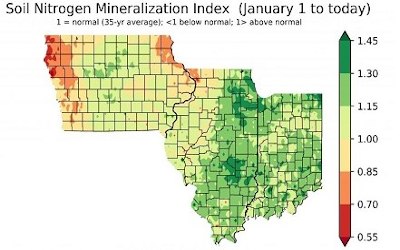By Sotirios Archontoulis
With hundreds and oftentimes thousands of acres under their control, farmers need good management tools to know what is going on in each field, and to manage the many variables that affect crop production.
For the past five years, agronomists at Iowa State University have been perfecting a weekly, real-time forecast to evaluate soil dynamics across specific field-scale sites, and across broader regions.
Known as the Forecast and Assessment of Cropping sysTemS (FACTS), the program combines information on weather, soil and crop data, to provide timely quantitative answers to common questions farmers ask, like what will the yield be, how much nitrogen is still in the soil, how much soil moisture is available, and how these factors will impact yield.
Weekly updates
Beginning April 15, the FACTS assessment will be updated with new data every Wednesday, continuing through harvest. Field-scale data is collected from Iowa State research farms, and regional data is compiled through modeling.
“The FACTS tool gives farmers and others data they cannot measure on their own, said Sotirios Archontoulis, associate professor of agronomy at Iowa State. “We go after the dynamics of important soil and crop processes to inform producers.”
Those “dynamics” can result in a farmer making a growing season change, or at the end of the year, help evaluate “what-if” scenarios regarding yield and nutrient management. FACTS is unique because it accounts for interactions among soil-crop-weather factors, and is managed by a team of specialists within Iowa State University’s Department of Agronomy.
The project was started in 2015 and has grown substantially during the past few years, to also include regional data for Illinois and Indiana, while the plan is to cover 12 states in 2020.

The FACTS project also includes a corn drydown calculator, which offers predictions of corn drydown in the field, using algorithms developed for the northern Corn Belt.
By providing farmers a “real-time” look at their soil-crop system, farmers can make predictions for their own farm about where an adjustment may need to be made.
“The model will show if you have stress and where you have stress,” Archontoulis said.
Making decisions
But the decision of what to do with the information is still up to the farmer.
“We do not provide recommendations; we provide key data sets for farmers to make their own decisions,” Archontoulis said.
For example, in the April 15 release, the team shows how the 2020 soil nitrogen mineralization compares with the past 35 historical years. Areas with below- and above-normal soil supply of nitrogen are illustrated – important information for nitrogen fertilization decisions.
Archontoulis and his team have compared their predictions against specific sites at Iowa State’s research farms, verifying the model’s prediction and explanatory accuracy using 96-site-years of data.
“We compiled the best validation dataset ever, which included time-series measurements of soil nitrogen, root depth, depth to water table, crop nitrogen uptake and crop staging, in addition to yields,” he said. “It was very good to see that the model simultaneously simulated well all of these different processes, which gives us confidence we get the right answer for the right reason – a very important aspect in modeling.”
Source : iastate.edu